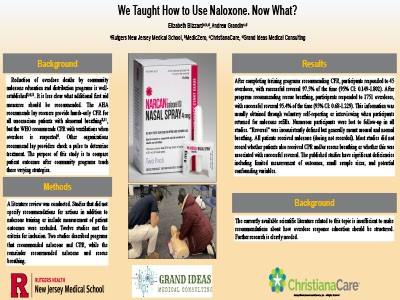ABSTRACTS
We Taught How to Use Naloxone. Now What?Author: Elizabeth Blizzard | | Associate Authors:
Introduction: Reduction of overdose deaths by community naloxone education and distribution programs is well-established. The efficacy of teaching bystanders additional first aid measures is less clear. The American Heart Association (AHA) recommends lay rescuers provide hands-only CPR for all unconscious patients with abnormal breathing, as delaying CPR greatly worsens outcomes and bystanders may hesitate while feeling for a pulse or worrying about breaths. However, the World Health Organization (WHO) recommends CPR with rescue breathing for suspected overdose because it is a hypoxic etiology requiring oxygenation. Other organizations recommend lay providers check a pulse to determine treatment since apnea with a pulse is more common in overdoses, particularly witnessed ones. Objectives: To compare patient outcomes after community programs to teach these varying strategies. Methods: A literature review was conducted. Studies that did not specify recommendations for actions in addition to naloxone training or include measurement of patient outcomes were excluded. Twelve studies met the criteria for inclusion. Two studies described programs that recommended naloxone and CPR, while the remainder recommended naloxone and rescue breathing. Results: After completing training programs recommending CPR, participants responded to 45 overdoses, with successful reversal 97.5% of the time (95% CI = 0.149–1.802). After completing programs recommending rescue breathing, participants responded to 1751 overdoses, with successful reversal 95.4% of the time (95% CI = 0.68–1.229). This information was usually obtained through voluntary self-reporting or interviewing when participants returned for naloxone refills. Numerous participants were lost to follow-up in all studies. “Reversal” was inconsistently defined but generally meant arousal and normal breathing. All patients received naloxone (dosing not recorded). Most studies did not record whether patients also received CPR and/or rescue breathing or whether this was associated with successful reversal. The published studies have significant deficiencies, including limited measurement of outcomes, small sample sizes, and potential confounding variables. Conclusion: The currently available scientific literature related to this topic is insufficient to make recommendations about how overdose response education should be structured. Further research is clearly needed.
|

